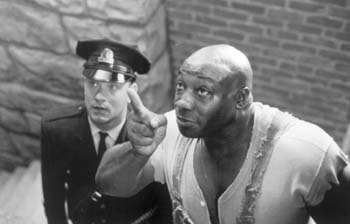![[MetroActive Movies]](/movies/gifs/movies468.gif)
[ Movies Index | Show Times | Santa Cruz Week | MetroActive Central | Archives ]
Big Mouse House
Frank Darabont and Stephen King's prestige prison pic shocks with sentiment and nostalgia
By Richard von Busack
TEAR-JERKING ought to be an art of omission. The intention to liquefy the audience is plain in The Green Mile, director Frank Darabont's first film since The Shawshank Redemption, and his second based on a prison novel by Stephen King. Condemned inmate John Coffey (Michael Clarke Duncan) is on the brink of tears throughout almost the entire three hours of the film. The sight of a huge, muscled man weeping seems like a corollary to that movie law laid down in Dogma: "There's nothing worse than a fat man crying." Yet in some respects, The Green Mile earns its tears, because its subject is our national shame: the mistreatment of prisoners.
Tom Hanks plays Paul Edgecomb, a prison guard watching over four men waiting for a seat in the electric chair at Cold Mountain Penitentiary in Louisiana during the 1930s. (Death row is nicknamed The Green Mile, because of its green linoleum.) The newest resident of the row is Coffey. Gradually, we learn that the convict has wonder-working powers. Edgecomb, who is suffering badly from some unspecified bladder disorder, is cured when Coffey lays one powerful hand on his crotch. Later, Coffey proves himself with even greater powers of healing when he revives Mr. Jingles, the pet mouse of death row. Now, Edgecomb, like Captain Vere in Melville's Billy Budd, is a man who has to hang--well, electrocute--an angel.
Although immaculately made, The Green Mile is rigged. We have the saintliness of Coffey, who won't put up a fight to save his life despite his blinding innocence. We also have the shameless coincidence that puts the real killer nearby. Suggesting that Coffey is too beautiful to live in this world is corny, as corny as telling us that his own free will is what matters--free will, in a man with as little education as Coffey? It's a matter of fact that not every convict is thinking clearly in jail and that sometimes other people have to do the thinking for them.
The King/Darabont jailhouse films are uplifters--consider the elevated reputation of The Shawshank Redemption, a good if not great film. But Darabont has roots as a horror scriptwriter (A Nightmare on Elm Street III), so he gives The Green Mile the touches that would please the King core audience, including a long, botched execution with flames shooting out of the victim's mouth. King published The Green Mile as the first serialized novel since the 1920s, in a gesture that was meant to recall the serial work of Dickens. No doubt, King is the Dickens this century deserved, and certainly Dickens was just as interested in the profound effect of violence on a reader. Here's the difference: King's stories of prison, unlike most of Dickens' tales, are set in the author's past, not his present. They don't challenge the packed-to-the-rafters prisons of 1999; they're set in a nostalgic 1950s in The Shawshank Redemption and 1930s in The Green Mile. The film is being released at exactly the right time of year, though, for an audience already swollen with emotion by the holidays. Thus, most won't look at it critically. Because here, in fine, is that real one-two punch of brutality and sentiment that gives our mainstream movies their power.
Copyright © Metro Publishing Inc. Maintained by Boulevards New Media.
![]()

Hanks for the Memories: Tom Hanks gets instructed by Michael Clarke Duncan in 'The Green Mile.'
The Green Mile (R; 182 min.), directed and written by Frank Darabont, based on the novel by Stephen King, photographed by David Tattersall and starring Tom Hanks, Michael Clarke Duncan and Michael Jeter, opens Friday at selected theaters.
From the December 8-15, 1999 issue of Metro Santa Cruz.